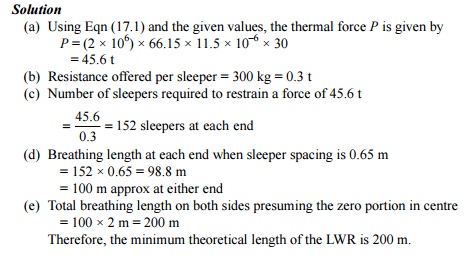Chapter: Civil : Railway Airport Harbour Engineering : Railway Engineering : Modern Welded Railway Track
Theory of Long Welded Rails
Theory
of Long Welded Rails
It is
well known that metals expand and contract with increase or decrease in
temperature, i.e., undergo thermal expansion. Thus, a rail expands and
contracts depending upon the variations in temperature. The expansion of a rail
is a function of the coefficient of the linear expansion of the rail material,
the length of the rail, and the variations in the rail temperature. Normally, a
free rail would undergo alterations in its length corresponding to the
variations in rail temperature, but as rails are fastened to sleepers, which in
turn are embedded in the ballast, their expansion and contraction due to
temperature changes are restricted. The restraint put on the thermal expansion
of rail gives rise to locked up internal stresses in the rail metal. The resulting
force, known as the thermal force, is given by the following equation:
P = E A aT (17.1)
where P is the force in tonnes, E is the modulus
of elasticity of rail steel = 2.15 × 106 kg/cm2 or 2150
t/cm2, A is the cross-sectional area of steel in cm2
and depends upon the individual rail section (for a 52-kg rail it is 66.15 cm2),
a is the coefficient of linear
expansion = 0.00001152 per o C, and T is the temperature variation in o C.
Substituting the values of E, A, a , and T, the force for every 1 o rise of temperature
for a 52-kg rail can be derived as follows:
P = (2.15 ×
10 6) × 66.15 × 0.00001152 × 1 × 10 -3 =
1.638 t per o C
The values of E and a are fixed for each type of rail steel. The value of the
cross-sectional area depends upon the sectional weight of the rail.
Substituting the value of sectional weight in kg/m Eqn (17.1), the force P
can also be given by the formula
P = 31.5AT
where, P is the force in kilograms, A is the
sectional weight in kg/m, and T is the temperature variation in o C. For
a 52-kg rail
P = 31.5 ×
52 kg per unit o C
=1638 kg =
1.638 t per o C
Longitudinal Thermal Expansion of LWR and
Breathing Length
In the
case of LWR, the thermal expansion of the rail takes place at the rail ends
because of temperature variations and the inability of the resisting force
offered by the rail and the ballast to overcome the same. A long welded rail
continues to expand at its ends up to that particular length at which an
adequate resisting force is developed towards the centre. A stage is finally
reached at a particular length of the rail from its ends when the resistance
offered by the track structure becomes equal to the thermal forces created as a
result of temperature variations. There is no alternation in the rail length
beyond this point. The cumulative value of the expansion or contraction of
these end portions of the rail (breathing lengths) is given by the formula

where, d l is the amount of expansion or
contraction of the rail, l is the breathing length of the
rail, a is the coefficient of thermal
expansion of the rail, and t is the variation in temperature. This value
of expansion or contraction of the rail is half the value that would have been
attained if the rail had been free to expand on rollers without any ballast
resistance. This alteration in length is confined to only a certain portion at
the ends of the LWR. The central portion of the LWR, where the force is
constant, is immobile and does not undergo any change in its length.
The portion at the end of the
long welded rail, which undergoes thermal expansion, is called the breathing
length. On Indian Railways this length is equal about 100 m at either end
of the rail in the case of BG tracks.
Example
17.1 Calculate the minimum theoretical length of LWR beyond which
the central portion of rail would not be subjected to any thermal
expansion, given the following data: cross-sectional area of a 52-kg rail
section = 66.15 cm2, coefficient of thermal expansion of rail steel
= 11.5 × 10 -6 per o C, temperature variation = 30 o C, modulus of
elasticity of rail steel = 2 × 10 6 kg/cm2, sleeper
spacing = 65 cm, and average restraining force per sleeper per rail = 300 kg.

Related Topics